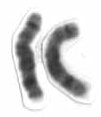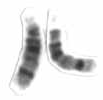Related Research Articles

Chromosome 21 is one of the 23 pairs of chromosomes in humans. Chromosome 21 is both the smallest human autosome and chromosome, with 45 million base pairs representing about 1.5 percent of the total DNA in cells. Most people have two copies of chromosome 21, while those with three copies of chromosome 21 have Down syndrome.

Chromosome 8 is one of the 23 pairs of chromosomes in humans. People normally have two copies of this chromosome. Chromosome 8 spans about 146 million base pairs and represents between 4.5 and 5.0% of the total DNA in cells.

Chromosome 9 is one of the 23 pairs of chromosomes in humans. Humans normally have two copies of this chromosome, as they normally do with all chromosomes. Chromosome 9 spans about 150 million base pairs of nucleic acids and represents between 4.0 and 4.5% of the total DNA in cells.

Chromosome 10 is one of the 23 pairs of chromosomes in humans. People normally have two copies of this chromosome. Chromosome 10 spans about 134 million base pairs and represents between 4 and 4.5 percent of the total DNA in cells.

Chromosome 14 is one of the 23 pairs of chromosomes in humans. People normally have two copies of this chromosome. Chromosome 14 spans about 101 million base pairs and represents between 3 and 3.5% of the total DNA in cells.

Chromosome 18 is one of the 23 pairs of chromosomes in humans. People normally have two copies of this chromosome. Chromosome 18 spans about 80 million base pairs and represents about 2.5 percent of the total DNA in cells.

Calcium-binding tyrosine phosphorylation-regulated protein is a protein that in humans is encoded by the CABYR gene.

Zymogen Granule Protein 16 is a protein that is encoded by the ZG16 gene. Other common names include hZG16, FLJ43571, FLJ92276, secretory lectin ZG16, jacalin-like lectin domain containing, JCLN, JCLN1, MGC183567, MGC34820, ZG16A, zymogen granule membrane protein 16, zymogen granule protein 16 homolog, and zymogen granule protein. The gene is located on Chromosome 16: 29,778,256-29,782,973. The gene obtains one transcript and 128 orthologues.

C8orf48 is a protein that in humans is encoded by the C8orf48 gene. C8orf48 is a nuclear protein specifically predicted to be located in the nuclear lamina. C8orf48 has been found to interact with proteins that are involved in the regulation of various cellular responses like gene expression, protein secretion, cell proliferation, and inflammatory responses. This protein has been linked to breast cancer and papillary thyroid carcinoma.
Chromosome 16 open reading frame 95 (C16orf95) is a gene which in humans encodes the protein C16orf95. It has orthologs in mammals, and is expressed at a low level in many tissues. C16orf95 evolves quickly compared to other proteins.

PRR29 is a protein encoded by the PRR29 gene located in humans on chromosome 17 at 17q23.

Retrotransposon Gag Like 6 is a protein encoded by the RTL6 gene in humans. RTL6 is a member of the Mart family of genes, which are related to Sushi-like retrotransposons and were derived from fish and amphibians. The RTL6 protein is localized to the nucleus and has a predicted leucine zipper motif that is known to bind nucleic acids in similar proteins, such as LDOC1.
BEND2 is a protein that in humans is encoded by the BEND2 gene. It is also found in other vertebrates, including mammals, birds, and reptiles. The expression of BEND2 in Homo sapiens is regulated and occurs at high levels in the skeletal muscle tissue of the male testis and in the bone marrow. The presence of the BEN domains in the BEND2 protein indicates that this protein may be involved in chromatin modification and regulation.

Chromosome 1 open reading frame 112, is a protein that in humans is encoded by the C1orf112 gene, and is located at position 1q24.2. C1orf112 encodes for seventeen variants of mRNA, fifteen of which are functional proteins. C1orf112 has a determined precursor molecular weight of 96.6 kDa and an isoelectric point of 5.62. C1orf112 has been experimentally determined to localize to the mitochondria, although it does not contain a mitochondrial targeting sequence.

C7orf50 is a gene in humans that encodes a protein known as C7orf50. This gene is ubiquitously expressed in the kidneys, brain, fat, prostate, spleen, among 22 other tissues and demonstrates low tissue specificity. C7orf50 is conserved in chimpanzees, Rhesus monkeys, dogs, cows, mice, rats, and chickens, along with 307 other organisms from mammals to fungi. This protein is predicted to be involved with the import of ribosomal proteins into the nucleus to be assembled into ribosomal subunits as a part of rRNA processing. Additionally, this gene is predicted to be a microRNA (miRNA) protein coding host gene, meaning that it may contain miRNA genes in its introns and/or exons.

Family with Sequence Similarity 166, member C (FAM166C), is a protein encoded by the FAM166C gene. The protein FAM166C is localized in the nucleus. It has a calculated molecular weight of 23.29 kDa. It also contains DUF2475, a protein of unknown function from amino acid 19–85. The FAM166C protein is nominally expressed in the testis, stomach, and thyroid.
The FET protein family consists of three similarly structured and functioning proteins. They and the genes in the FET gene family which encode them are: 1) the EWSR1 protein encoded by the EWSR1 gene located at band 12.2 of the long arm of chromosome 22; 2) the FUS protein encoded by the FUS gene located at band 16 on the short arm of chromosome 16; and 3) the TAF15 protein encoded by the TAF15 gene located at band 12 on the long arm of chromosome 7 The FET in this protein family's name derives from the first letters of FUS, EWSR1, and TAF15.

THAP domain-containing protein 3 (THAP3) is a protein that, in Homo sapiens (humans), is encoded by the THAP3 gene. The THAP3 protein is as known as MGC33488, LOC90326, and THAP domain-containing, apoptosis associated protein 3. This protein contains the Thanatos-associated protein (THAP) domain and a host-cell factor 1C binding motif. These domains allow THAP3 to influence a variety of processes, including transcription and neuronal development. THAP3 is ubiquitously expressed in H. sapiens, though expression is highest in the kidneys.

Transmembrane protein 19 is a protein that in humans is encoded by the TMEM19 gene.

Zinc Finger Protein 62, also known as "ZNF62," "ZNF755," or "ZET," is a protein that in humans is encoded by the ZFP62 gene. ZFP62 is part of the C2H2 Zinc Finger family of genes.
References
- 1 2 "FSCB - Fibrous sheath CABYR-binding protein - Homo sapiens (Human) - FSCB gene & protein". www.uniprot.org. Retrieved 2017-03-23.
- ↑ "Entrez Gene: Fibrous sheath CABYR binding protein" . Retrieved 2014-02-18.
- ↑ "FSCB fibrous sheath CABYR binding protein [Homo sapiens (human)] - Gene - NCBI". www.ncbi.nlm.nih.gov. Retrieved 2017-03-23.